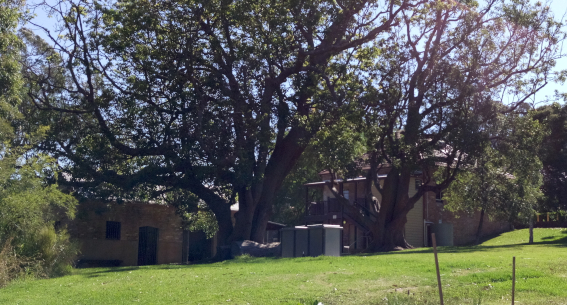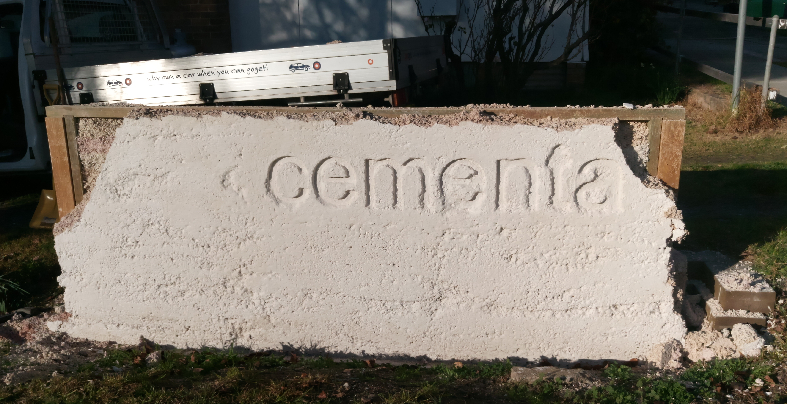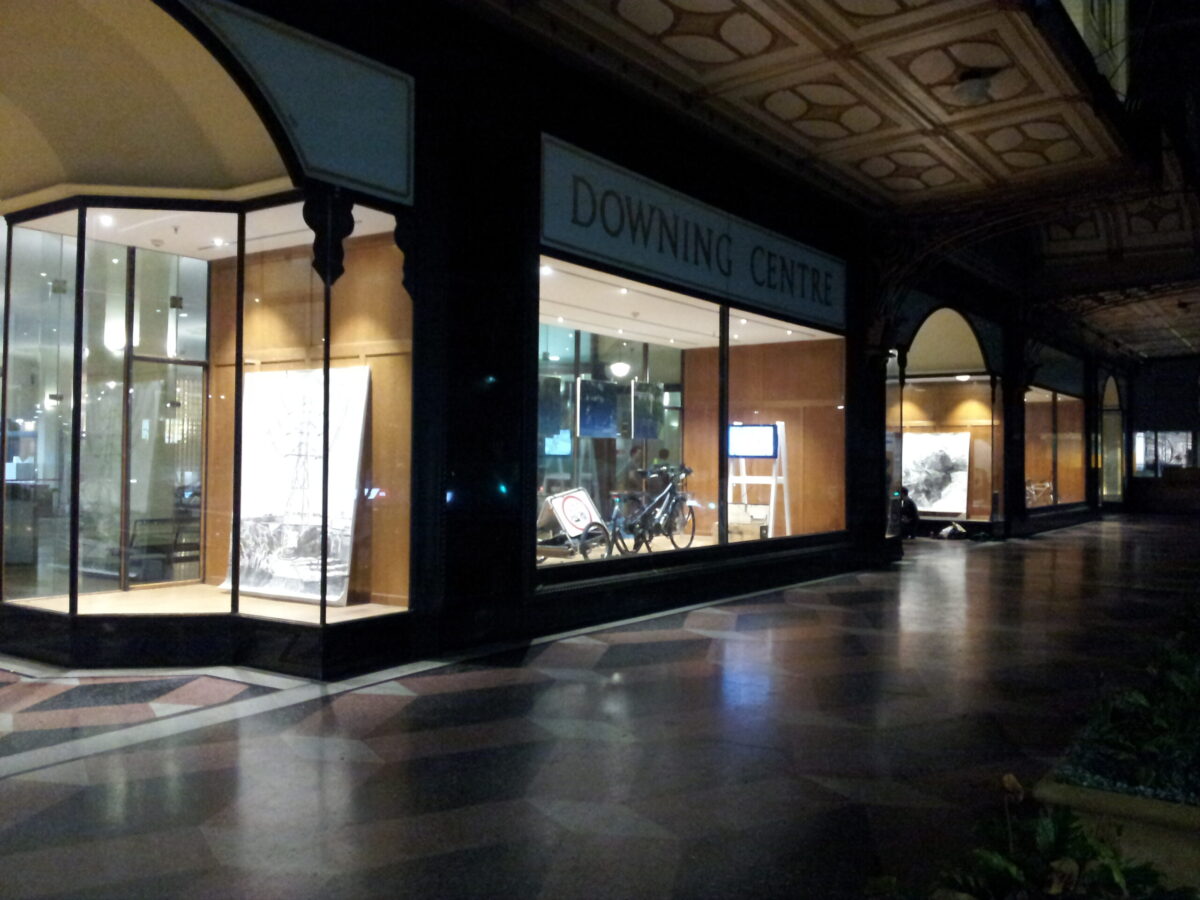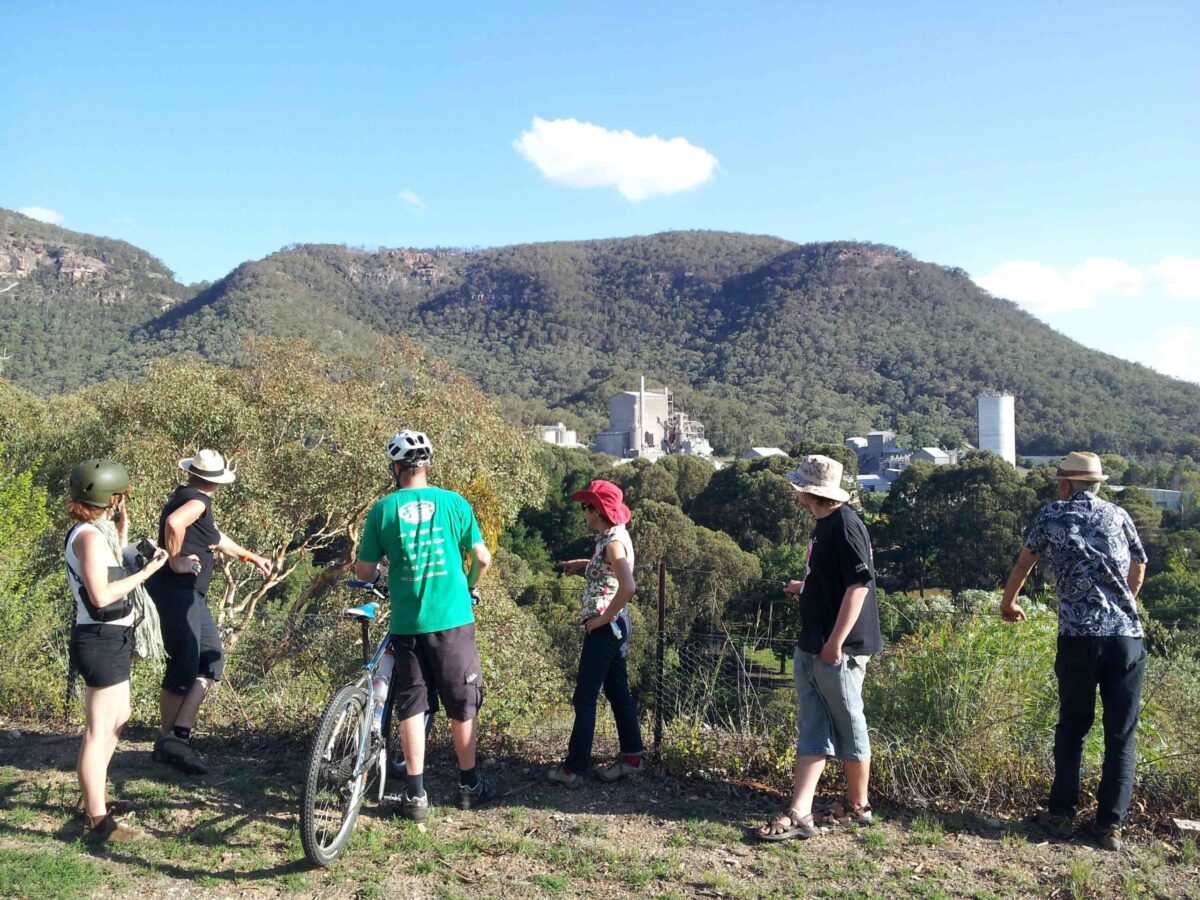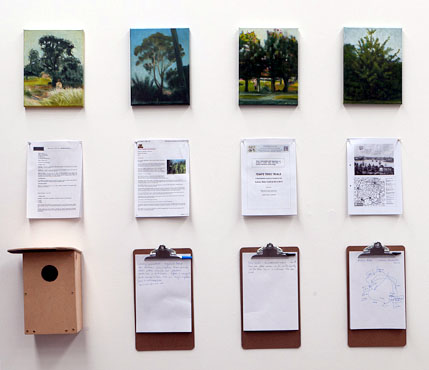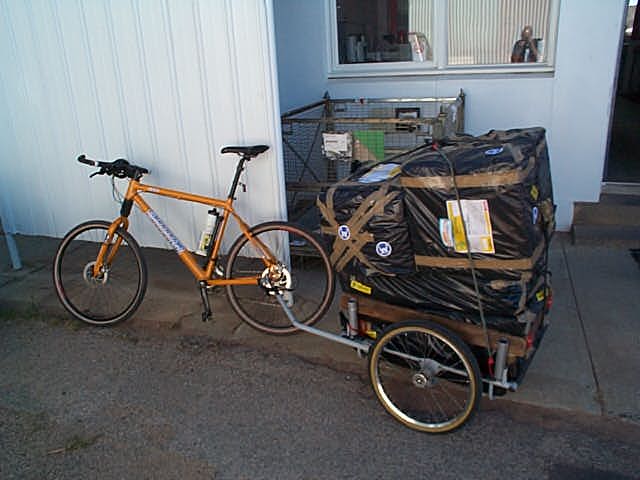2020
Culture At Work
recycled timber pallets, plastic, pvc pipe, organic matter, soil, plants
dimensions variable
From 2020 a pair of Wick’d Beds was placed in the rear of Culture at Work in Pyrmont. Then moved to the front courtyard and refilled with layers of timber offcuts, greenwaste and soil. From there the beds were planted out with various herbs and natives. The beds use recycled material to contain a portable garden bringing life to paved and covered areas, ameliorating the heat sink effect of hard surfaces and providing a talking point for visitors.
A series of beds was constructed for a project placing wicking beds on the Sydney Green Ring. COVID19 delayed the roll out. Culture at Work has since shut its doors due to the untimely passing of its prime mover Sherryl Ryan. Two Wick’d Beds were also featured at Hazelhurst Regional Gallery and Art Centre at Gymea. The Wick’d Beds were constructed and some are still functioning at Frontyard Projects in Marrickville.
A catalogue of images showing the research and construction and ongoing development of the Wick’d Beds https://photos.app.goo.gl/kNCCcJeVLPy3fMrL9
2019
White Creek Cottage Residency
An artist residency awarded by Inner West Council. Begun in October of 2018 and completing in October of 2019. The chance to creatively explore materials and themes to do with the environment, the Sydney Green Ring, and the urban wildlife habitat.
Due to the Amalgamation of the three Councils there was some lag time organising the new tenants and so the residency was extended to April 2020. By which time COVID19 restrictions had kicked in upsetting the timeline and completion of some of the proposed projects.
All in all an excellent location and a productive residency. Many thanks to the crew from Inner West Council that makes it happen, and their ongoing support for the arts.
2016
The Hemp Initiative

L-R Ann Finnigan, Alex Wisser, Sam Paine, Gilbert Grace.
The Cementa ceremonial gate by artist, Gilbert Grace. The hempcrete wall was constructed from Australian and imported hemp hurds/shiv, Australian certified lime binder, with oxides as colouring agent. Hempcrete as a building product is one of the many applications of industrial hemp. Thanks to Australian Hemp Masonry for the instruction and support in this project.
The inaugural residency for the Kandos School of Cultural Adaptation is a collaboration with Stuart Andrews of Natural Sequence Farming fame, exploring the potential of low THC industrial hemp, for the purposes of land rejuvenation.
Hemp is one of the first plants to be domesticated by humans, for human and animal food, cloth and paper making fibre. With tens of thousands of industrial applications low THC industrial hemp is sess petrochemical dependent than either flax or cotton, every part of the plant provides raw materials for mature industries, with myriad new applications found annually.
Every product that can be created from mineral oil has, or can be, created from hemp. It is an opportunity that is too good to ignore. The ongoing suppression of hemp is to the detriment of human health, wealth and happiness.
Retro-innovation is the underlying zeitgeist that has seen the revival of crafting, of the revaluing of artisanal skills, and the desire for a return to “heirloom quality”. The revival of real skills are necessary for resilience into the 21st century, to add meaning and beauty to our lives, and to live with grace and dignity within ecologically defined limits.
See also the article: Hemp Hope in Kandos, Mudgee Guardian, 5 December, 2016.
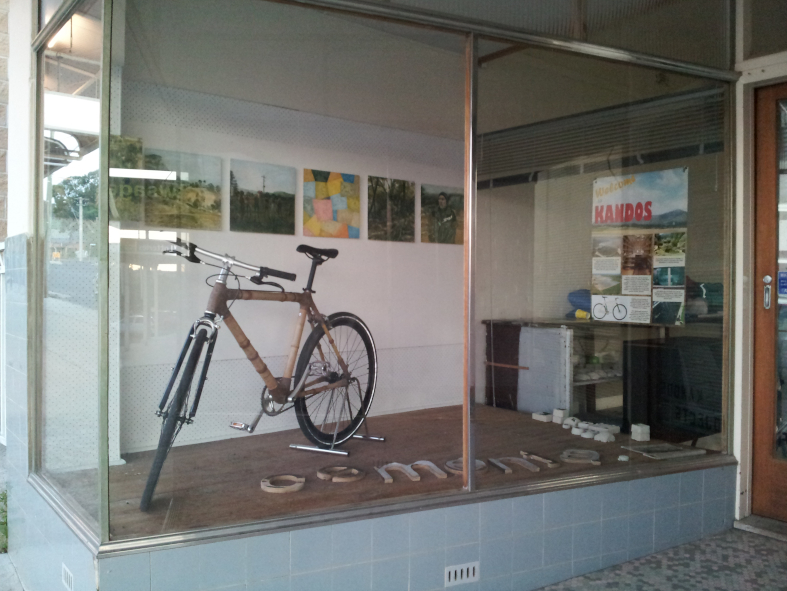
I can recommend hemp and bamboo as a combination for many manufactured goods, the Calfee Bamboo Bike and Spedagi Bamboo Bikes are particularly great examples. I cannot recommend this Chinese manufactured kit that in no way lived up to the hype and the glossy website. Bamboo if not acclimatised and treated with the proper care and attention will split as it absorbs and expels moisture from the atmosphere. The bike frame began splitting before it was even completely assembled and this prevented the purchase of more frames that would have been the basis of a fleet of bamboo bikes for KSCA.
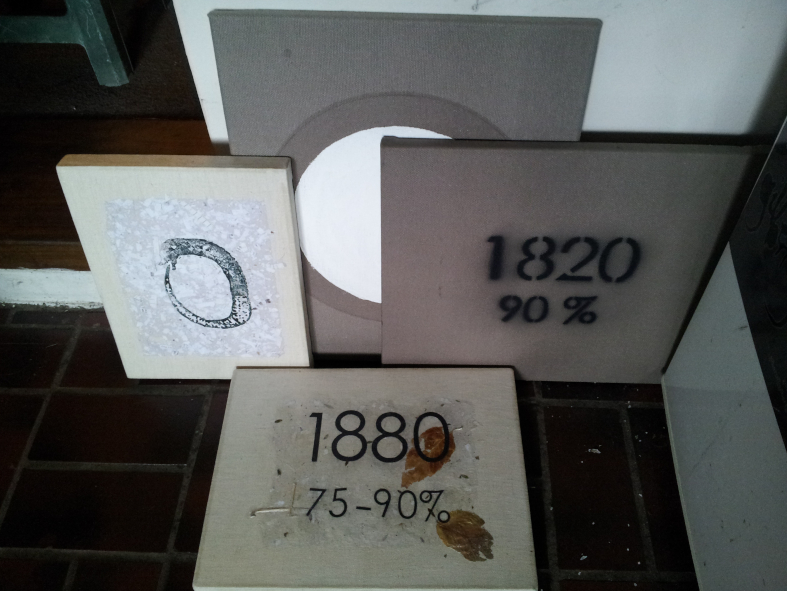
Reading through conservators reports, facts about hemp use emerged on the painting supports used by well known European artists in the 1800s. Prior to 1820 when the cotton gin was introduced and cotton manufacturing became affordable, with a corresponding increase in slavery, 90% of supports were made of hemp. Consequently hemp rag was the main feedstock for paper up till the 1880s. Fabriano originally grew fields of hemp for paper production and has only recently begun incorporating hemp into its premium paper. This confirms that hemp was often included in the euphemism “linen” to appease later scholars and bureaucrats with a political aversion to cannabis.
I originally planned and hoped the Cementa Ceremonial Gate could be built in a far-off paddock closer to where the crop would have been grown and where, unprotected, it could have aged and crumbled according to the weather; the components, the lime and hurd, adding to the texture of the soil. Alas it was not to be. The Gate was graffitied by a disgruntled local and that hastened the decision to manually dismantle it. The materials now lie enriching the soil in a garden in the far off coastal village of Elizabeth Beach.
Research for the Hemp Initiative revealed that canvas – a traditional support for artists paintings – was first produced from hemp, Cannabis sativa (Linnaeus), “canvas” being a mispronunciation of ‘cannabis’ attributed to the Dutch.
A hardwearing fibre and one of the strongest organic fibres, cannabis hemp was one of the first plants cultivated by humans for multiple uses including cloth. Art conservation work showed that around 1820, just before the cotton gin really took off, a large proportion of master artists used hemp as a support.
What is often referred to generically as “linen” would have been hemp, especially bed clothes and under garments. Cotton and real linen were as expensive as silk.
Hemp rag was the major feedstock for “rag paper” until the 1870s, collected by the ‘rag and bone men’. After the 1820s hemp rag declined being replaced by cotton.
Fabriano grew fields of hemp to supply its paper manufacturing. The Arsenal in Venice was used to store the hemp cordage for the Venetian navy.
The availability of hemp is due to it being favoured by mariners. Passed through smoke from a bitumen fire, its waterproofing and ability to resist rot is enhanced for all manner of maritime uses, sails, cordage, uniforms, caulking, etc. Even the seeds making a good porridge and the oil useful in fine paints and timber finishes. The first usage for sail is often traced to Nordic Vikings who exported their ship building skills to the rest of Europe through conquest and trade.
The first usage for cordage and paper originating in China. It was the attempt to supplant hemp organic products with petroleum synthetic products that saw it hemp demonised in the 1920s and 1930s by the motor vehicle petroleum and associated corporations including the Hearst “yellow journalism” news papers. Hemp oil can be substituted for diesel fuel with some minor engine modification.
Having found a suppliers of hemp fabric in Australia I tested a variety of weaves and weights to find those that took collagen (rabbit skin) glue well and did not buckle from uneven tension on warp and weft weave. I found a supplier of heavy weight 100% hemp, an upholstery fabric that took glue well, retained its surface shape, and produced a very adequate painting support.
An illustration short clip of how effective the hemp/rabbit skin glue combination on strainer bars (fixed corners). The drum tightness is a pleasure to paint on, https://youtube.com/shorts/RWtjfulsslc. Painting examples are below.
Cotton “duck” is a generic mispronunciation of the Dutch word for sailing canvas – ‘doek’. While cotton fabric is softer it is also less resistant to wear and rot. The growing of cotton requires more inputs, fertilizers, herbicides, fungicides and pesticides, water and fuel for machinery.
The benefits of hemp as a rotation crop are well understood and well documented. Impediments to greater exploitation of hemp for industrial uses rests on persistent falsehoods and misinformation designed to marginalise hemp production and product development.
2015
Deep Green and Bright Blue – Downing Centre
Deep Green and Bright Blue – SCA Lilyfield
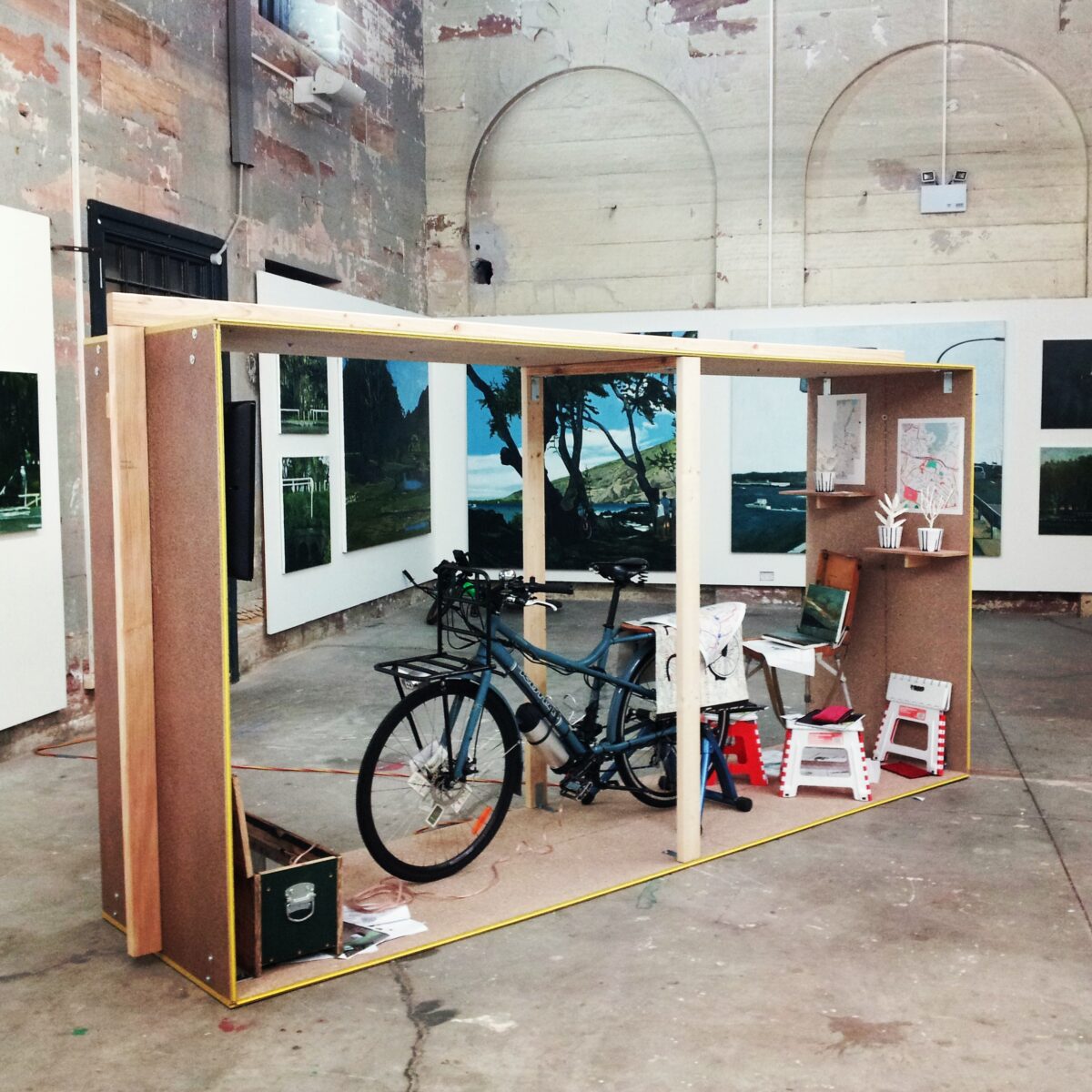
Sydney College of the Arts Gallery, Lilyfield, Culture At Work, Pyrmont, and Big FAG Press, Glebe.
2013
Inner West Light Rail Shelter Screens
I was one of three local creatives commissioned to create designs for the Light Rail Shelters along the Inner West extention from Lilyfield to Dulwich Hill. The design brief was managed by GuppyAssociates, the other aritsts are Graham Chalcroft of Vertebrae and Sarah Drury of Slingshot Design. There are a number of other artists involved in mosaic and sculpture and bicycle parking shelters.
Arlington Light Rail
in PicPerf by Locker.
Sticking to the brief the focus was on local history. The Arlington Screen, left to right contains: a paragraph from page 307 of the facsimile of James Cook’s Endeavour journal describing the inhabitants of “New Wales”. Next an illustration of a Kongouro by George Stubbs an inflated Kangaroo skin was the model, the Petersham area had the colloquial name of Kangaroo Ground. “Convicts in Sydney“, 1793, by Filipe Bauza or Juan Ravenet, relates to James Bloodworth and his common law wife Sarah Bellamy, convicts who from their allocation of 25 acres each grew their estate to 250 plus acres. The Moon Rocket shadowing the convicts is still standing in Johnson Park and was manufactured by Dick West. This text is from an account of how William Bradley came to be commander of the Comet. Comet windmills were produced in a factory adjacent to the goods line and exported globally.
Taverners Hill Light Rail
in Pic Perf by Locker
The Taverners Hill design riffs on the image of the Black Swan. “The Black Swan of Trespass” is the title of the first poem is a collection of verse titled the Darkening Ecliptic, the greatest literary hoax Australia has ever seen that is set in and around the Inner West of Sydney. Promulgated by two Fort Street High School and Sydney University old boys, James Macauley and Harold Stewart.
The pair were trained poets with an aversion to the unbridled anti-formalism of modernist free verse. Macauley and Stewart, as non combatant conscripts stationed at Victoria Barracks in Melbourne, together in a single afternoon concocted what they thought an apt parody of modernist poetry. They cobbled together parts of Macauley’s existing unpublished poetry with nonsense grabs from text books, stream of consciousness, and other mock surrealist devises.
The target of their jape was Max Harris the 22 year old enfant terrible editor of “Angry Penguins” a modernist literary journal based in Adelaide supported by John Reid of Heide fame. The star of their ruse was a deceased motor mechanic Ernest Lalor Malley, with an interest in mosquitos and bicycles. Macauley and Stewart grew up and lived in the suburbs in and around the locality Taverners Hill.
And what is a tavern for but the telling of tall stories and pranks that and deflate stuffed shirts. Macauley began an Anglican, renounced religion and then converted to Catholicism. He went on to become editor of Quadrant another of the journals supported by the CIA’s clandestine soft diplomacy. Stewart emigrated to Japan and become a monk and expert on Japanese artefacts.
Nassim Nicholas Taleb is a former stock broker and author who is fixated on randomness and mathematics. His book The Black Swan is a best seller and gives authoritative accounts of how randomness interacting with fractal mathematics form the geometry of the universe. The base image is of the outline of Sydney Harbour overlaid on Jackson Pollock’s painting “Blue Poles” a scandalous purchase at the time with deep repercussions with cold war CIA sponsored soft diplomacy.
Hawthorne Light Rail
in Pic Perf by Locker.
The Hawthorne shelter screen design is a collage based on the two types of mangrove common in the Sydney waterways around the time the canal was developed, overlaid with various frames from artwork in the Art Gallery of New South Wales.
Originally the park land was mudflats and saltwater marsh with mangroves. With the accumulation of effluent from the housing further up stream the salt marsh became a foetid swamp. One plan was to connect the Hawthorn Canal via Long Cove Creek to the Cooks River, this being a low point in the ridge line between the two water catchments.
Having water from Sydney Harbour flood and flush the slower tidal Cooks River would negate dredging works that CSR had to maintain to get barges to and from its sugar refinery at Canterbury. This was a sister project to a canal linking Botany Bay with Sydney Harbour via Shae Creek and through Redfern, another low point in the ridge line between catchments.
Neither canal project eventuated as developments in rail and road transport outpaced and relegated barges. The solution was to fill the low lying marsh and construct a canal that a ferry could navigate at high tide.
Super Six
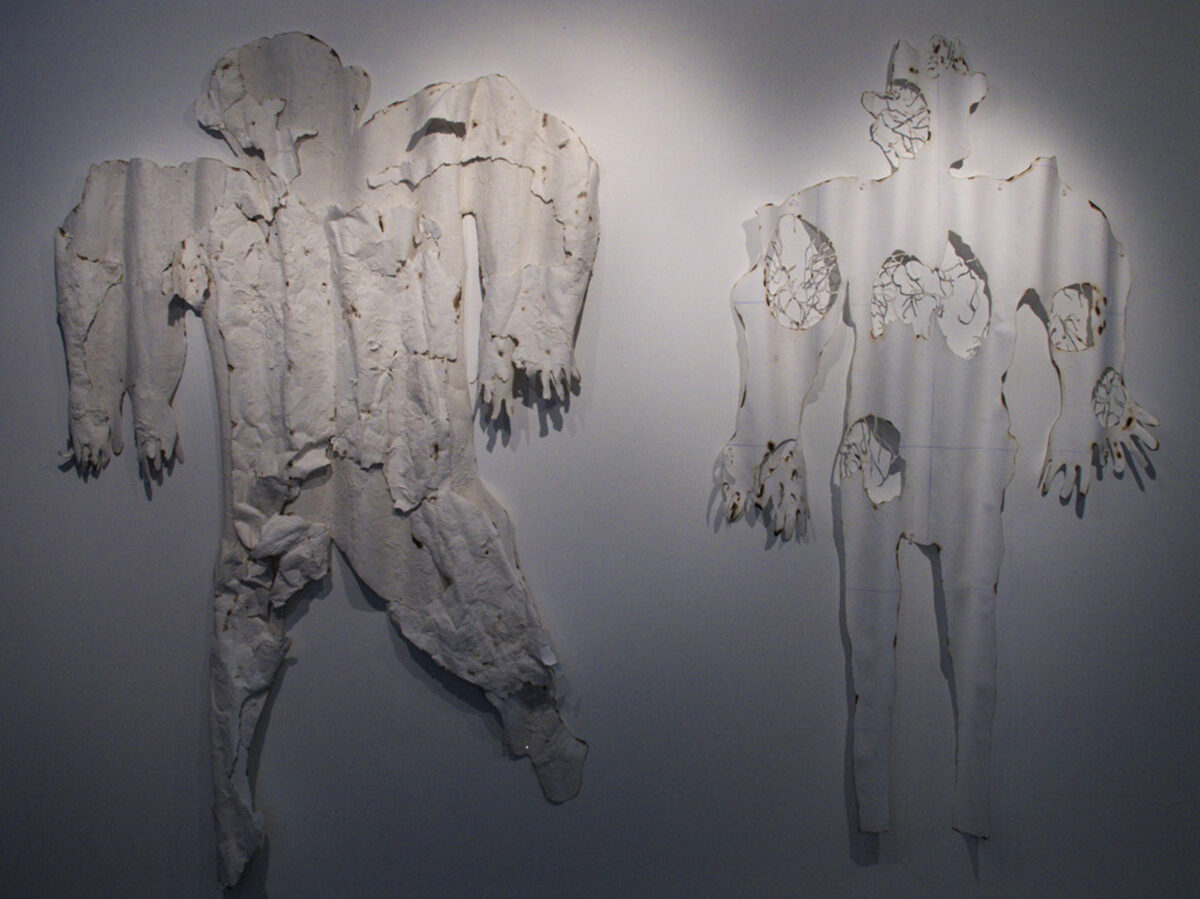
shaped, cut, and burned Fabriano paper, plaster, fibreglass, blue chalk.
Dimensions variable.
Super Six Tour
We interwove sites of significance in the study of asbestos with the Inner West with Food and Art Trail to ensure the appetite for art and refreshment were catered to. More photos at https://www.facebook.com/pages/Super-Six/651703291530145 .
The beauty of the artworks delicately counterposed the brutality of the (non-) application of law and commerce in the real world.
Adrian Clement’s review appeared in Das Platforms Emerging and Contemporary Art, 19 January 2014 http://www.dasplatforms.com/writing/super-six.
The Common Wheel – Pyrmont Rolling Sketch Tours
A series of sketch tours, a bicycle rally, and a ‘radonneur’ style ride, were part of The Common Wheel residency and exhibition at Accelerator Gallery for Culture At Work, Pyrmont.
ARTcycle Sketch Tours – Cementa 13
Surveying the site of the cement works from near the grounds of the Managers House, while David Standfield (with bicycle) describes the day to day realities of living in Kandos while the cement works were operating.
Cementa 13 was an amazing get together of artists, arts administrators, art appreciators and some often bemused, often enthused locals in the rural NSW town of Kandos. The town lost 98 jobs when the cement works closed down, the Bylong Valley is currently in the news for other reasons.
GPS tracking (and some make do infill when the GPS failed) was used to create this drawing using google maps.
View Cementa_13 – Drawing Kandos in a larger map
ARTcycle Sketch Tours and Bicycle Hire have been generously supported by a CASP grant from Regional Arts NSW
2012
Sydney Green Ring – Propositional Works
‘ARTcycle – Residency Action Committee Vehicle’ – Residency and Group Show, INDEX space 2012.
The works illustrate various trees to be found on the GreenWay (and Sydney Green Ring) with suggestions as to proposed or speculative projects that could be accomplished.
This project was supported by a grant from the New South Wales Government – Arts NSW and the Visual Arts and Craft Strategy, an initiative of the Australian, State and Territory Governments. The program is administered by the National Association for the Visual Arts (NAVA).
2011
Taking a Line for a Ride
‘Sketching the Gamut’ – Group Show, INDEX space, St Peters. October 2011.
‘Taking a Line for a Ride’ is a play upon the phrase attributed to Paul Klee, “Drawing is taking a line for a walk”. Klee’s use of whimsy oft belied the seriousness of his intent, which seemed like an excellent place to begin.
As the theme for the exhibition was drawing the Sydney Green Ring, using a bicycle to draw in this way seemed entirely appropriate.
The video was a response to Lucas Ihlein’s, Mont Royal, Montreal, time lapse video in the Bicycle Film Festival 2007 ‘Bespoke‘ exhibition at Mori Gallery.
More about the Sketching the Gamut show here, http://thegamutsydney.blogspot.com.au/
This project was supported by a grant from the New South Wales Government – Arts NSW and the Visual Arts and Craft Strategy, an initiative of the Australian, State and Territory Governments. The program is administered by the National Association for the Visual Arts (NAVA).
‘Many Hans Make Light Work’
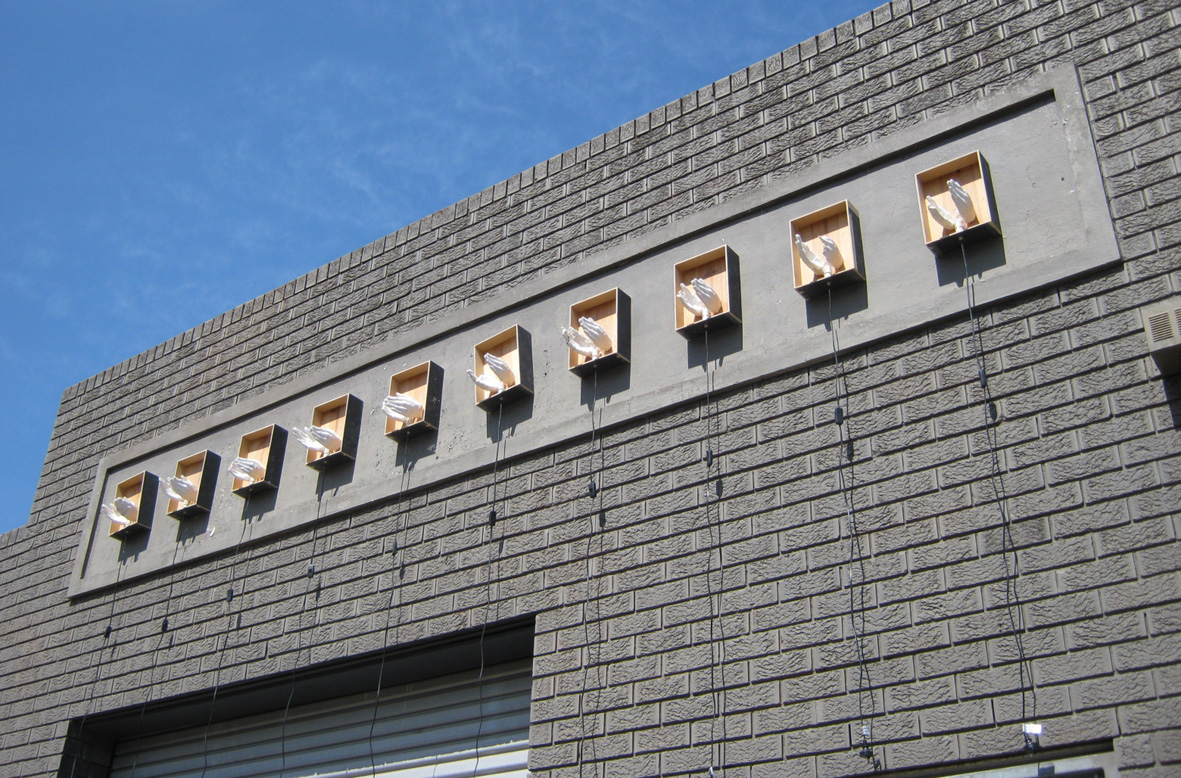
mixed media assemblage light installation
dimensions variable
The materials for this installation are all recycled, with the exception of the light fittings. The sculptural hands are from the ‘Presumption of Regularity’ vehicle, and are themselves based upon the cliched and statistically most reproduced image in history, Albrecht Durer’s, ‘Praying Hands’. The mdf used was reclaimed from an installation in The Ghost Show at Hazelhurst Gallery. The pine is a gift of dumpster diving in Hutchinson St, St Peters.
It could be critiqued in terms of Nicolas Bourriaud’s ‘post production’, being inspired by the works of Christian Boltanski and Hans Haacke.
It got its first outing during the ‘In The Night Garden’ show, part of the 2011 Sydney Fringe Festival. And again in the ‘RAG Time’ Show, at Global Gallery, Paddington, 2011.
2009
‘The Presumption of Regularity’
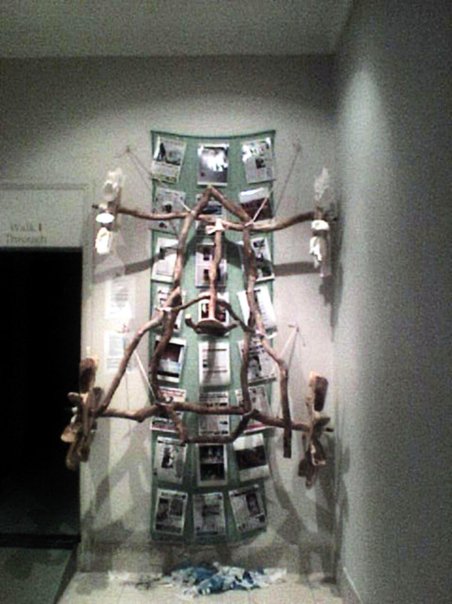
mixed media installation, dimensions variable.
Installation view – At The Vanishing Point Contemporary Gallery, Newtown, 19 June – 5 July 2009.
‘Reality Cheque’ – ATVP, Newtown.
‘Breathing Space’ – Hawksbury Regional Gallery, Windsor.
‘Trauma Porn’ – ATVP, Newtown.
During the SIEV X affair Tony Kevin, a high ranking government official, claims the then Liberal Government relied on the ‘presumption of regularity’ to cover activities that breached international maritime conventions and covenants.
The crew of Bock’s Car, following the blessing from a catholic priest, dropped ‘fat man’ on Nagasaki missing its target by a mile and destroying the Mitsubishi torpedo factory. Collateral damage was the Urakami Catholic Cathedral and half Nagasaki’s 14,000 Catholics who had long been persecuted by the local authorities.
In Australia ‘our’ answer to queue jumpers, was to strip them of their humanity locked away in detention centres; some would eventually be driven insane and/or perform acts of self harm. These people – legitimate asylum seekers – were attempting to escape the bombing that has been unleashed upon civilians in countries ‘we‘ are invading while providing for ‘our‘ (and our allies) ‘energy security’ – i.e. profits.
Thanks to the GreenWay Project for the ‘fallen limbs’.
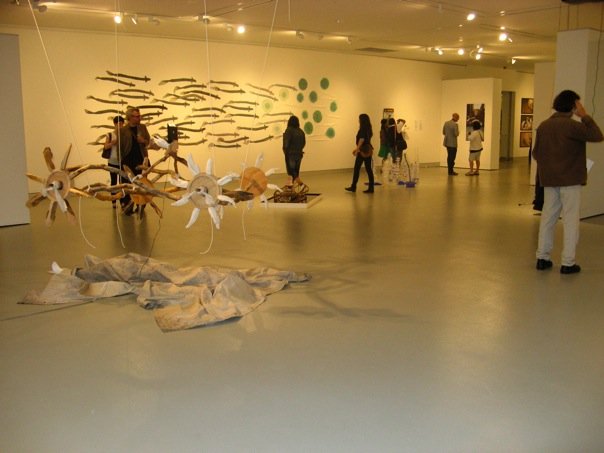
mixed media,
dimensions variable
Installation view, ‘Breathing Space’ – Hawkesbury Regional Gallery, Windsor, 18 September – 25 October 2009.
2001
Palimpsest 4
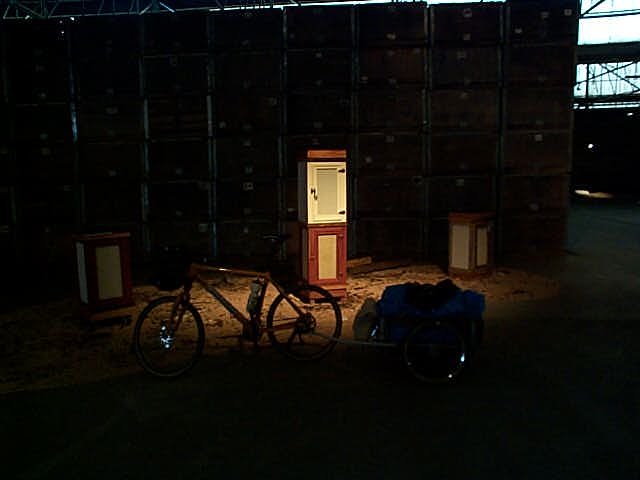
four modular, flat-packed, Coolgardie-style, food safes,
dimensions variable.
Installation view – ‘Palimpsest 4’ – Aurora packing shed, Red Cliffs/Mildura.
The project was underpinned by a concern for sustainable husbandry and manufacturing. Materials were found, reclaimed and purchased. Fabrics include hemp (subject of research trials), cotton (a large scale crop with its own chemical load), and charcoal (a potential new industry). Materials that, along with flax, the oil from various seeds, and earths, form the basis of traditional painting techniques. Western White Gum (Chinchilla) was obtained after viewing ABC Landline program. The project was a response to the theme of sustainable use of resources and the effects of salination of the Murray and surrounding environment.
The bicycle is still one of the most extensively used and least polluting forms of transport and a reliable workhorse. The bicycle has become an integral part of my practice, a necessary and affordable intervention into contemporary, motor-vehicle dependent lifestyle. I rode from Mildura, via Virginia, to Goolwa at the mouth of the Murray. One of the most bizarre moments of the ride was crossing the Murray River at Blanchetown.
